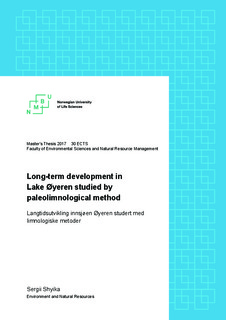| dc.contributor.advisor | Rohrlack, Thomas | |
| dc.contributor.advisor | Riise, Gunnhild | |
| dc.contributor.author | Shyika, Sergii | |
| dc.coverage.spatial | Norway | nb_NO |
| dc.date.accessioned | 2017-07-19T12:31:39Z | |
| dc.date.available | 2017-07-19T12:31:39Z | |
| dc.date.issued | 2017 | |
| dc.identifier.uri | http://hdl.handle.net/11250/2449027 | |
| dc.description.abstract | Lake Øyeren is a freshwater lake in SE-Norway that is located in the lower part of the river Glomma, having a large drainage area. In the northern part of the lake, river Glomma and two smaller rivers have built up the largest inland delta of Northern Europe.
This study has two major purposes: (1) to reconstruct the long-term development in primary production of Lake Øyeren; (2) to identify inorganic pollution from local and long-range sources based on paleolimnological methods. Additionally, the impact of flooding and water level regulations on sediment transport in the lake was discussed. The sediment cores obtained from the deeper Øyeren basin were analysed to determine pigments and elements (macro- and trace elements) in the lake’s sediment.
In the first part of the thesis, the general information about Lake Øyeren and anthropogenic impact on its ecosystem are represented. The data obtained from the sediment cores were systemized and presented. The unusual period with a sharp increase in sedimentation rate and pigment amount was detected. That phenomenon was attributed to an internal movement of surface sediment. The multivariate relations between the sediment parameters were analysed by principal component analysis, while the multivariate relations between the parameters and explanatory variables (weather conditions) were analysed by redundancy analysis. Finally, the obtained results were interpreted in the discussion part with respect to the historical records from the catchment area. Also, the direct comparison of the water quality monitoring data and sediment records was conducted.
The research covers the development study of Lake Øyeren from the 1960s until present. It was concluded that the primary production remains at the same level as at the beginning of the 1960s, despite the high nutrient loading. The major sources of inorganic pollution since the 1970s until present are most probably an anthropogenic atmospheric deposition and upstream mineral particles, while for the 1960s we have observed the effect of point source pollution. Flood events and water level regulations seem to have a minor impact on the sedimentation rate. | nb_NO |
| dc.language.iso | eng | nb_NO |
| dc.publisher | Norwegian University of Life Sciences, Ås | nb_NO |
| dc.rights | Attribution-NonCommercial-NoDerivatives 4.0 Internasjonal | * |
| dc.rights.uri | http://creativecommons.org/licenses/by-nc-nd/4.0/deed.no | * |
| dc.subject | Øyeren | nb_NO |
| dc.subject | Paleolimnology | nb_NO |
| dc.subject | Sedimentology | nb_NO |
| dc.subject | Trace elements | nb_NO |
| dc.subject | Chlorophylls | nb_NO |
| dc.subject | Carotenoids | nb_NO |
| dc.title | Long-term development in Lake Øyeren studied by paleolimnological method | nb_NO |
| dc.title.alternative | Langtidsutvikling innsjøen Øyeren studert med limnologiske metoder | nb_NO |
| dc.type | Master thesis | nb_NO |
| dc.description.version | submittedVersion | nb_NO |
| dc.subject.nsi | VDP::Mathematics and natural science: 400::Zoology and botany: 480::Limnology: 498 | nb_NO |
| dc.subject.nsi | VDP::Mathematics and natural science: 400::Geosciences: 450::Sedimentology: 456 | nb_NO |
| dc.subject.nsi | VDP::Agriculture and fishery disciplines: 900::Agriculture disciplines: 910::Management of natural resources: 914 | nb_NO |
| dc.subject.nsi | paleolimnology | nb_NO |
| dc.source.pagenumber | 36 | nb_NO |
| dc.description.localcode | M-MINA | nb_NO |

